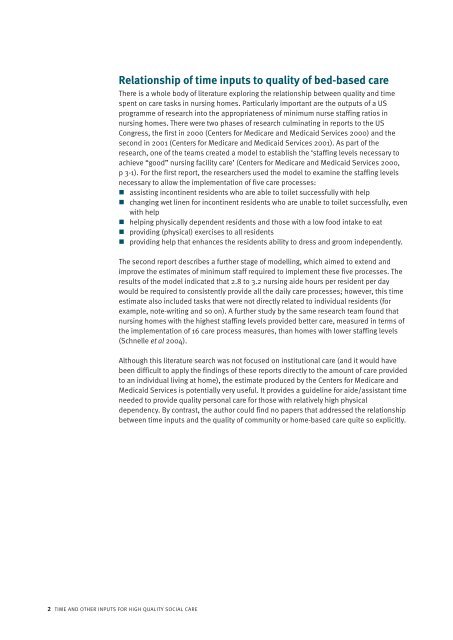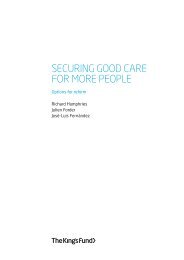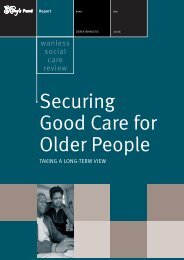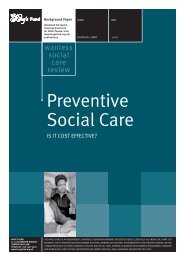Time and other inputs for high quality social care - The King's Fund
Time and other inputs for high quality social care - The King's Fund
Time and other inputs for high quality social care - The King's Fund
Create successful ePaper yourself
Turn your PDF publications into a flip-book with our unique Google optimized e-Paper software.
Relationship of time <strong>inputs</strong> to <strong>quality</strong> of bed-based <strong>care</strong><br />
<strong>The</strong>re is a whole body of literature exploring the relationship between <strong>quality</strong> <strong>and</strong> time<br />
spent on <strong>care</strong> tasks in nursing homes. Particularly important are the outputs of a US<br />
programme of research into the appropriateness of minimum nurse staffing ratios in<br />
nursing homes. <strong>The</strong>re were two phases of research culminating in reports to the US<br />
Congress, the first in 2000 (Centers <strong>for</strong> Medi<strong>care</strong> <strong>and</strong> Medicaid Services 2000) <strong>and</strong> the<br />
second in 2001 (Centers <strong>for</strong> Medi<strong>care</strong> <strong>and</strong> Medicaid Services 2001). As part of the<br />
research, one of the teams created a model to establish the ‘staffing levels necessary to<br />
achieve “good” nursing facility <strong>care</strong>’ (Centers <strong>for</strong> Medi<strong>care</strong> <strong>and</strong> Medicaid Services 2000,<br />
p 3-1). For the first report, the researchers used the model to examine the staffing levels<br />
necessary to allow the implementation of five <strong>care</strong> processes:<br />
• assisting incontinent residents who are able to toilet successfully with help<br />
• changing wet linen <strong>for</strong> incontinent residents who are unable to toilet successfully, even<br />
with help<br />
• helping physically dependent residents <strong>and</strong> those with a low food intake to eat<br />
• providing (physical) exercises to all residents<br />
• providing help that enhances the residents ability to dress <strong>and</strong> groom independently.<br />
<strong>The</strong> second report describes a further stage of modelling, which aimed to extend <strong>and</strong><br />
improve the estimates of minimum staff required to implement these five processes. <strong>The</strong><br />
results of the model indicated that 2.8 to 3.2 nursing aide hours per resident per day<br />
would be required to consistently provide all the daily <strong>care</strong> processes; however, this time<br />
estimate also included tasks that were not directly related to individual residents (<strong>for</strong><br />
example, note-writing <strong>and</strong> so on). A further study by the same research team found that<br />
nursing homes with the <strong>high</strong>est staffing levels provided better <strong>care</strong>, measured in terms of<br />
the implementation of 16 <strong>care</strong> process measures, than homes with lower staffing levels<br />
(Schnelle et al 2004).<br />
Although this literature search was not focused on institutional <strong>care</strong> (<strong>and</strong> it would have<br />
been difficult to apply the findings of these reports directly to the amount of <strong>care</strong> provided<br />
to an individual living at home), the estimate produced by the Centers <strong>for</strong> Medi<strong>care</strong> <strong>and</strong><br />
Medicaid Services is potentially very useful. It provides a guideline <strong>for</strong> aide/assistant time<br />
needed to provide <strong>quality</strong> personal <strong>care</strong> <strong>for</strong> those with relatively <strong>high</strong> physical<br />
dependency. By contrast, the author could find no papers that addressed the relationship<br />
between time <strong>inputs</strong> <strong>and</strong> the <strong>quality</strong> of community or home-based <strong>care</strong> quite so explicitly.<br />
2 TIME AND OTHER INPUTS FOR HIGH QUALITY SOCIAL CARE
















